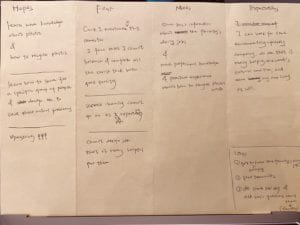Question: Research about plastic, what types of plastic exist? how do you recognize it?
Answer: According to the essay “Plastic: Different Types” from The Hutchinson Unabridged Encyclopedia with Atlas and Weather Guide, I get to know about the basic categories of plastic. Based on the reaction they have when being heated, we can generally divide plastic into two different types. One is thermoplastic, which “soften when warmed, then re-harden as they cool”. The other is thermosets, in contrast, it will “remain rigid once set, and do not soften when warmed”.
The former one includes examples such as some clear plastics used in kitchen utensils or (when expanded into a ‘foam’ by gas injection) in insulation and ceiling tiles; polyethylene or polythene, used for containers and wrapping; and polyvinyl chloride (PVC), which is the most familiar to us, used for drainpipes, floor tiles, audio discs, shoes, and handbags.
The latter one is usually used in electrical insulation and telephone receivers; epoxy resins because of its property that will not be affected by the heat. It is also commonly used in paints and varnishes, to laminate wood, and as adhesives; polyesters, used in synthetic textile fibers and, with fiberglass reinforcement, in car bodies and boat hulls; and polyurethane, prepared in liquid form as a paint or varnish, and in foam form for upholstery and inlining materials (where it may be a fire hazard).
Besides, there are also plastics like Silicones, which usually called Si, and are widely applied in silicone rubber, paints, electrical insulation materials, laminates, waterproofing for walls, stain-resistant textiles, and cosmetics. This is because Si is a kind of chemically inert material, has good electrical properties, and repel water.
And I also find one plastic that really intrigues me. It is a kind of plastics that has shape-memory. In other words, it can be crumpled or flattened and will resume their original shape when heated. They include trans polyisoprene and polynorbornene. The initial shape is determined by heating the polymer to over 35°C and pouring it into a metal mold. The shape can be altered with boiling water and the substance solidifies again when its temperature falls below 35°C.
After acquiring all of this basic knowledge, I find out that plastic-used products are actually everywhere around us, but it is hard for us to recognize them all correctly. In my opinion, one of the methods for us to get to know about them is to do research and make it clear about where plastics may be used in and what specific type of plastic it is. Besides that, recognizing them through the official label may be a wise way. For instance, the label that number 1 wrote inside the recycle logo means PET, which stands for the kind of plastic that is only suitable for plastic bottles containing mineral water or carbonated beverage, etc. I think this is the easiest and most popular way for people to recognize different types of plastics, although some plastics contained in other synthesized materials may still hard to discover.
